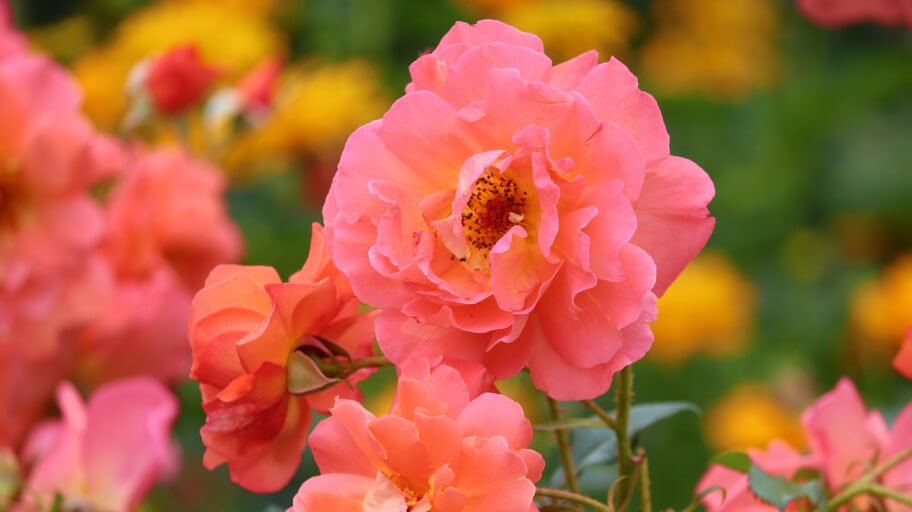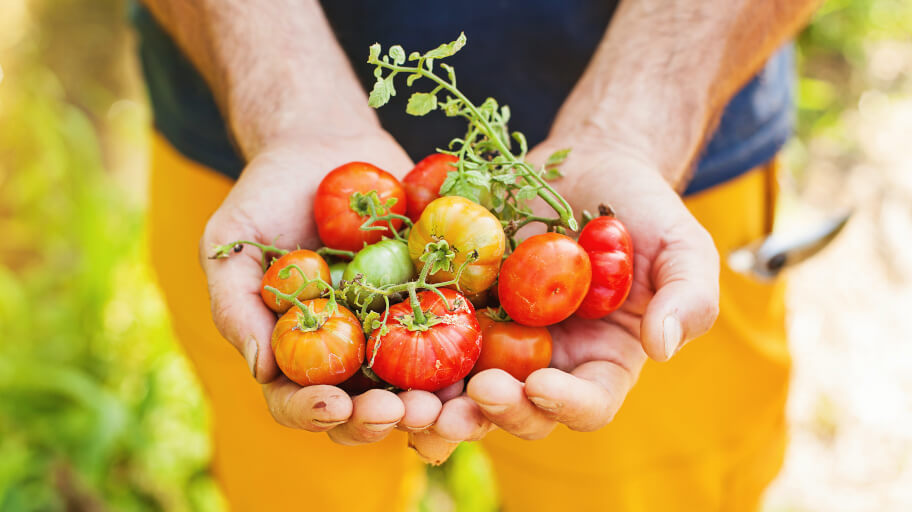
Child-proofing your home or daycare centre is a tough job, but not impossible. Anything in the reach of a child can be a threat to their health. Ordinary objects can become weapons. Plants are no exception.
List of child-friendly house plants:
- African Violet
- Aluminum Plant
- Anthurium
- Aphelandra
- Baby’s Tears
- Begonia
- Bloodleaf
- Boston Fern
- Christmas Cactus
- Coleus
- Corn Plant
- Dracaena
- Emerald Ripple Peperomia
- Hen-And-Chickens
- Hoya
- Impatiens
- Jade Plant
- Lily
- Parlor Palm
- Prayer Plant
- Rubber Plant
- Schefflera
- Sensitive Plant
- Snake Plant
- Spider Plant
- Swedish Ivy
- Velvet, Purple Passion
- Wandering Jew
- Weeping Fig
Even non-toxic plants can cause an unwanted reaction if they’re eaten, so try to keep them out of reach nevertheless. Alternatively, try to establish rules with your children. The best advice we can give you is: Assume plants are poisonous unless you know otherwise. Seek urgent medical attention if you see any symptoms like rash, swollen tongue or lips, and difficult breathing.
African Violet

Latin name: Saintpaulia
Description: The African Violet is a common house plant suitable for any beginner gardener. It lives long and adjusts to a variety of conditions. It can be grown both indoors and outdoors. It is very low maintenance and takes up little space. All varieties of Saintpaulia have pretty purple, blue, pink, red, or white flowers. Keep the African Violet out of cold and direct sun, because it will lead to discolouration. Water it from the bottom, as any water on the leaves turns them brown. Let the roots dry before you water it again. Pinch dead blossoms to stimulate blooming.
Children: Kid-friendly plant.
Pets: Safe for cats and dogs.
Aluminium Plant

Latin name: Pilea Cadierei
Description: If you want to enhance the appearance of your home you can pick an Aluminium Plant from the store. It has beautiful dark green leaves with silvery stripes. It’s an easy to grow evergreen plant. When it blooms it does so with small white flowers. You can grow it in baskets, letting it hang down from the ceiling. The Aluminium Plant loves the sun, but keep it in a partial shade during summer. In winter, you can put this child-friendly plant in a well-lit area near a window. If you want to stimulate growth – pinch out the growing tips. To prevent it from becoming spindly – trim back from time to time.
Children: Safe for children.
Pets: Toxic for cats and dogs.
Anthurium / Taliflower / Flamingo Flower / Laceleaf
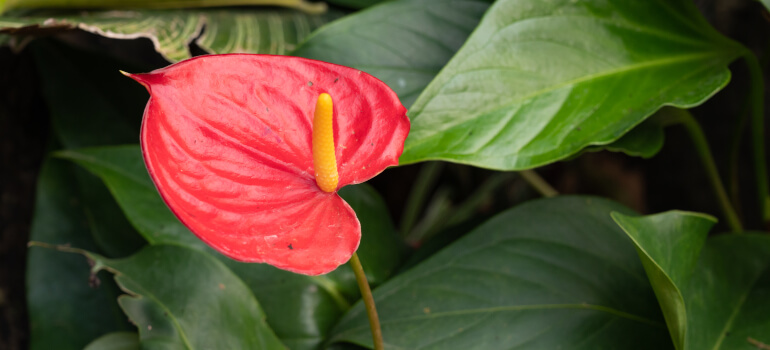
Latin name: Anthurium sp.
Description: The Anthurium has big, bright coloured flowers in white, yellow, red, pink, orange or green. It doesn’t need much water , so forgetting to water it for a bit is a non-issue. Make sure the soil is well-drained to prevent rotting. Anthurium loves well-lit places, but avoid putting it in direct sunlight or near heaters. It is safe for children to touch the plant, but chewing any part of the plant can result in burning of the mouth and lips. So we recommend keeping the Anthurium high up and away from small children.
Children: Safe for children if they don’t eat it.
Pets: Toxic for cats and dogs.
Aphelandra / Zebra Plant
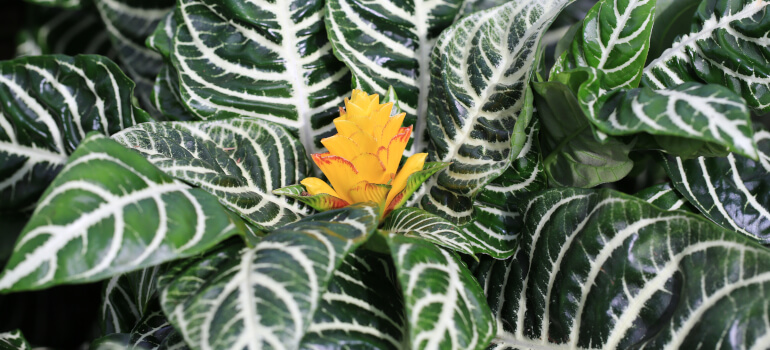
Latin name: Aphelandra Squarrosa
Description: As the plants above the zebra plant prefers indirect sunlight. You have to be precise with the watering. Too much or too little water can turn the leaves brown or cause them to fall out. Keep the soil moist. As every tropical plant the Aphelandra loves warmth and humidity. If you want to make it bloom you’ll have to recreate its natural rhythm. Water it less water and lower the temperature to simulate winter. After it wakes up from its winter sleep it will develop new heads of blooms. Then put it in the brightest area of your home and water it generously.
Children: Safe for children.
Pets: Toxic for cats and dogs.
Baby’s Tears Plant / Angel’s Tears / Mind-Your-Own-Business / Peace-In-The-Home / Pollyanna Vine / Polly Prim / Mother Of Thousands / Corsican Curse

Latin name: Soleirolia Soleirolii
Description: This plant with fragile leaves is suitable for all kinds of garden experiments. It’s often used for terrarium decoration as it likes moisture and shade. It looks dramatic hanging from the edges of pots. Try growing it in bottles. You will be surprised how easy it is! You can grow it in your home or outside. The plant doesn’t bloom, but the leaves are vibrant green and will freshen the interior of your home. The Baby’s Tears plant is incredibly easy to take care of, so if you have a busy schedule it will fit perfectly. It’s a huge plus that it takes as much space as you want it to.
Children: Safe for children.
Pets: Safe for cats and dogs.
Begonia

Latin name: Begonia Obliqua
Description: Begonias grow best in shaded or partially shaded areas, preffering humid places with cool soil. They can’t survive a harsh winter, so consider moving them inside after temperatures start to drop. Begonias are most praised for their beautiful flowers. People have cultivated them for a long time and now there are many varieties to choose from. The most popular Begonias to grow inside are the rhizomatous and the fibrous-rooted, while tuberous begonias are suitable for growing outside (e.g. From hanging pots or baskets). Begonias bloom in red, orange, yellow, or white colours.
Children: Safe for children.
Pets: Safe for cats and dogs.
Bloodleaf / Bloodroot / Iresine / Chicken Gizzard
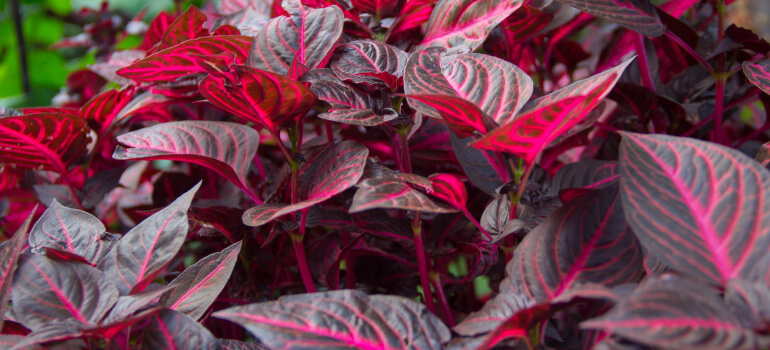
Latin name: Iresine Herbstii
Description: If you’re looking for something different for your garden, you should consider growing Iresine. These are plants from the amaranth family. They have reddish trichome leaves. A few bushes will add colour diversity and character to your garden. You can use it to make interesting landscaping patterns. If you want to keep them compact and bushy, you’ll have to prune them in spring. Some mistakenly think it’s an aquarium plant. The truth is that Bloodleaf plants will wither if kept for too long under water.
Children: Safe for children.
Pets: Safe for cats and dogs.
Boston Fern / Sword Fern / Tuber Ladder Fern / Fishbone Fern
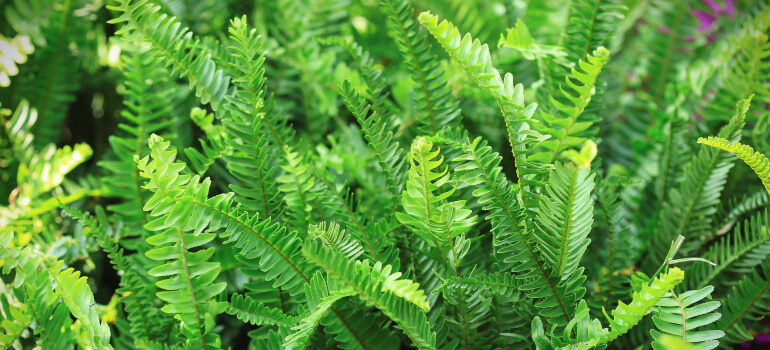
Latin name: Nephrolepis Exaltata
Description: Boston Ferns are incredibly easy to take care of. They love cool, humid places with indirect sunlight. Not a lot of houseplants have these environmental preferences, so the Boston Fern is a perfect candidate for that shady, lonely corner of your living room. Keep the soil damp and you won’t make a mistake. If the air in your house is too dry – spray some water on its leaves. You will easily know if your Boston Fern is not getting enough water by its leaves – they will turn yellowish-brown. To encourage it to grow thicker you have to prune the old discoloured leaves.
Children: Safe for children.
Pets: Safe for cats and dogs.
Christmas Cactus / Easter Cactus / Thanksgiving Cactus
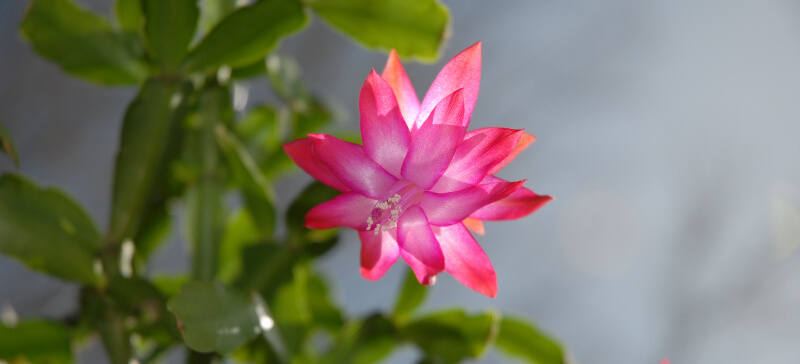
Latin name: Schlumbergera
Description: If many of your flowers bloom in the springtime and summertime, here’s something different. As you probably have already guessed, this cactus blooms around Christmas. It is easy to care for it in average household conditions. It will adapt to lower light, but provide it with lots of sunshine and it’ll bless you with beautiful red flowers. When it comes to water, keep in mind it’s a cactus and it doesn’t need much of it, but never let it dry out completely. Around October stop watering the plant for a month. This will encourage the Christmas cactus to develop buds. If they drop off, it’s probably due to over-watering or not enough sunlight.
Children: Safe for children.
Pets: Safe for cats and dogs.
Coleus / Painted Nettle
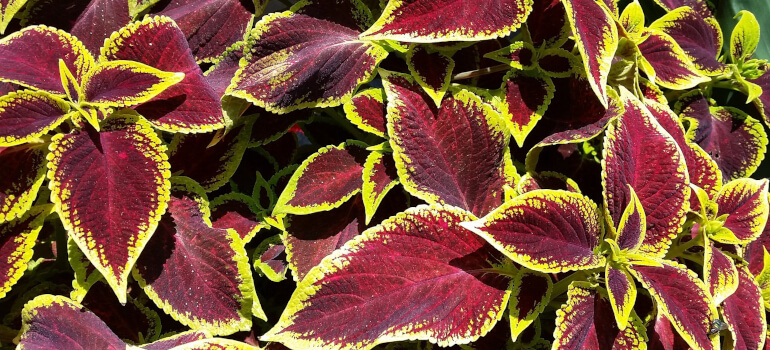
Latin name: Plectranthus Scutellarioides
Description: The Coleus plant is incredibly easy to grow, which makes it suitable for beginners. If you want to engage your children in gardening, this is a perfect place to start. To distribute it you just have to make cuttings and put them in water. And voila! Roots will start to form. The Coleus plant varies in shape, size and colouration. You can’t go wrong no matter which type you choose. Its colours are usually red, green and white and you can use it to diversify your garden’s overall look. It is suitable to plant in the same container with other flowers or nearby them.
Children: Safe for children.
Pets: Safe for cats and dogs.
Corn Plant / Striped Dracaena / Chinese Money Tree / Fortune Plant
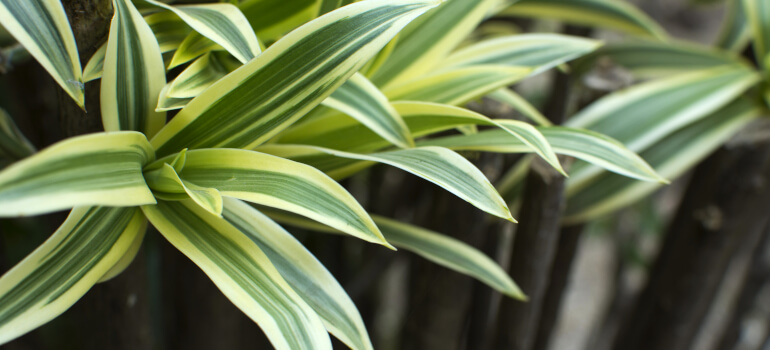
Latin name: Dracaena Fragrans
Description: The Fortune Plant comes from tropical Africa and has found it’s way to our homes. The leaves look like corn leaves, hence one of its names. The Striped Dracaena enjoys moderate shade and high humidity. To keep up with its requirements spray the leaves with water. Let the soil dry slightly between waterings. As any tropical plant this one loves warmth and it will definitely refuse to grow in colder temperatures. Anything lower than 10 degrees will make the plant wither.
Children: Safe for children.
Pets: Mildly toxic to cats and dogs.
Dracaena
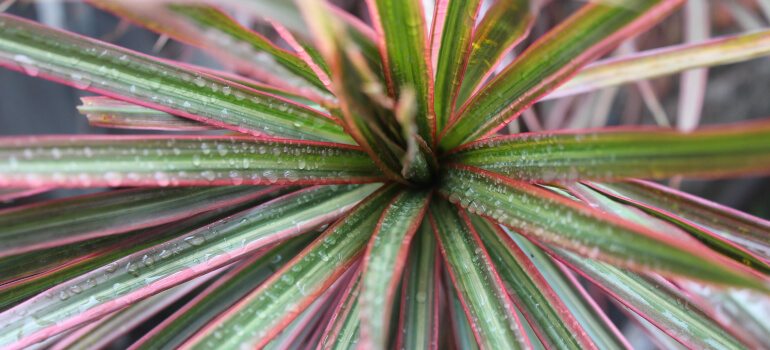
Latin name: Dracaena Marginata, Sanderiana, Deremensis, Draco, Cinnabari
Description: The Dracaena is a very popular plant for offices, malls, and homes. You can choose from their diverse variety to give any room a sense of style. The Dracaenas can be a bit difficult to take care of, but if you follow our tips and you will have a flourishing, healthy plant. Dracaenas need well moisturised soil, but never leave it soggy. Make sure the soil can quickly drain. Fertilise the plant every two weeks during spring and summer. Dracaenas love the sun, so keep them near a window. Don’t worry about the temperature too much, as long as it’s not freezing cold.
Children: Safe for children.
Pets: Some species of the dracaena family can be irritating to pets, so look up the one you have at home.
Emerald Ripple Peperomia / Emerald Ripple Pepper / Peperomia / Ivy-Leaf Peperomia
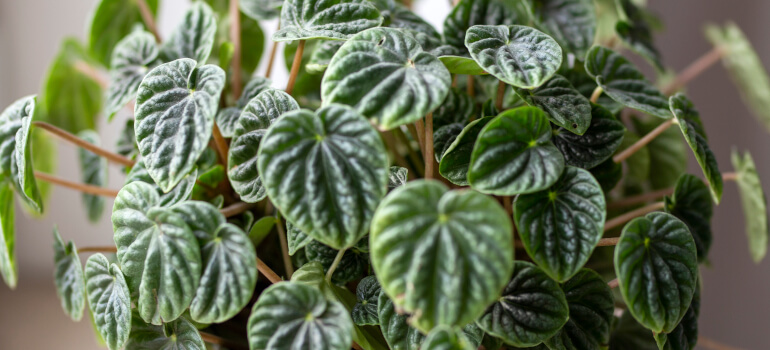
Latin name: Peperomia Caperata
Description: Something specific about the Pepermonia is that it likes shadier places during summer, but in winter it needs as much light as possible. It can also grow with only fluorescent light, which makes it ideal for terrariums. It can also be placed in mixed planters. Prune the plant in the warmer seasons to keep it bushy. Keep the temperatures average and don’t let it drop under 10°C. Let the soil dry before you water it again. If you live somewhere where you don’t get frost in winter, you can use the Pepermonia as ground cover.
Children: Safe for children.
Pets: Safe for cats and dogs.
Hen-And-Chicks Plant / Hen-And-Biddies / Houseleeks

Latin name: Sempervivum
Description: Hen-And-Chicks is a group of succulent plants. The name refers to the fact one mother rosette forms many babies around it. These sweet-looking succulents have adapted to harsh conditions and can thrive in both cold and hot weather. Bear in mind however that if the temperature gets too low or high the plant will cease growing. They make excellent container plants. You should grow them in low in nutrients gritty soil and water them scarcely. The low requirements makes Hens-And-chicks ideal for people with busy schedule.
Children: Safe for children.
Pets: Safe for cats and dogs.
Hoya / Waxplant / Waxvine / Waxflower / Hindu Rope / Porcelain Flower

Latin name: Hoya
Description: There are around 200-300 species, which found their way from Asia to homes all over the world. Hoyas have waxy leaves, hence the common name. They are evergreen and can grow to enormous proportions. The soil needs to be light and well drained. You will enjoy a healthy plant as long as you keep it out of direct sunlight. To make your Hoya plant bloom it needs a break during winter. Keep the temperatures low and reduce the intake of food and water.
Children: Safe for children.
Pets: Safe for cats and dogs.
Impatiens / Touch-Me-Not / Jewelweed / Snapweed / Patience
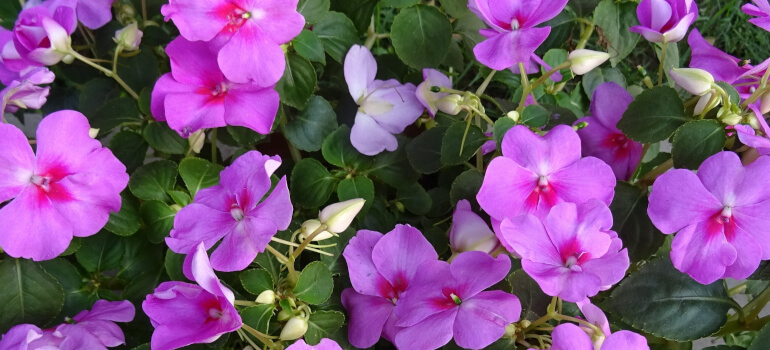
Latin name: Impatiens
Description: Impatiens is easy to grow plant with beautiful flowers. It likes shade and cool moist soil. The closer they’re planted together, the taller they get. So plant the flowers 8 to 10 inches apart or keep them in separate pots. Water the plants regularly, but don’t keep them too wet. Impatiens has many names but the Latin name comes from the way the plant spreads – it has seed pods and when ripe they burst and scatter everywhere. Thus, it may be invasive and not recommended to grow in Australia. You can also propagate Impatiens through cuttings.
Children: Safe for children.
Pets: Safe for cats and dogs.
Jade Plant / Friendship tree / Lucky plant / Money tree
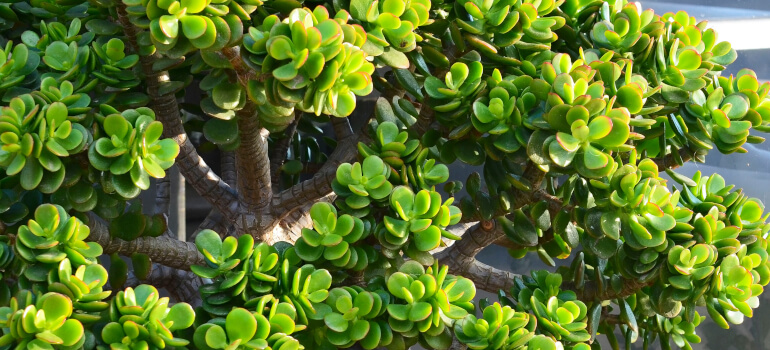
Latin name: Crassula ovata
Description: Jade plant is very appealing with its miniature tree-like looks. You can have it as a normal houseplant in a pot or turn it into a bonsai tree. It’s incredibly easy to look after and you don’t have to water it frequently as other common household plants. It likes warm and dry conditions. Dampening the soil too much may cause the roots to rot. Put the jade plant in a sunny place near a window during the summer and make sure to remove it away from the cold window sills in the winter. You can easily harvest jade plants by just sticking leaves in well-drained soil. You can expect it to start growing in a few weeks.
Children: Safe for children.
Pets: Toxic for cats and dogs.
Lilies

Latin name: Hemerocallis lilioasphodelus
Description: To the joy of many women around the world, you can grow these exotic looking flowers in a pot at home. All you need is healthy bulbs and medium to large pot. Make sure the soil drains well, as that’s very important for the flower. Sandy soil is the best for lilies. To continue having these beautiful flowers, fertilise the soil often. Don’t overwater it. Stick your finger in the soil to check if it’s dry or moist. If it’s moist, wait a little. To overwinter the lilies just leave them in the same pot, just cut the stalks off and stop watering them. Put them somewhere inside like in the basement and leave them like this. If it’s too warm they won’t blossom next summer. If taken care of properly, you’ll enjoy them for years to come.
Children: Safe for children.
Pets: Toxic for cats, safe for dogs.
Parlor palm / Neanthe bella palm

Latin name: Chamaedorea elegans
Description: The name suits the Parlor palm very much and it can make any room more elegant. It’s perfectly suited for apartments and offices and it’s often picked for it’s air purifying qualities. And if you don’t have a lot of space at home, that’s okay, because the Parlor palm is a slow grower, especially if you keep it away from windows. It thrives in low-light environments and direct sunlight can do more damage than good. Water it sparingly.
Children: Safe for children.
Pets: Safe for cats and dogs.
Prayer plant / Maranta
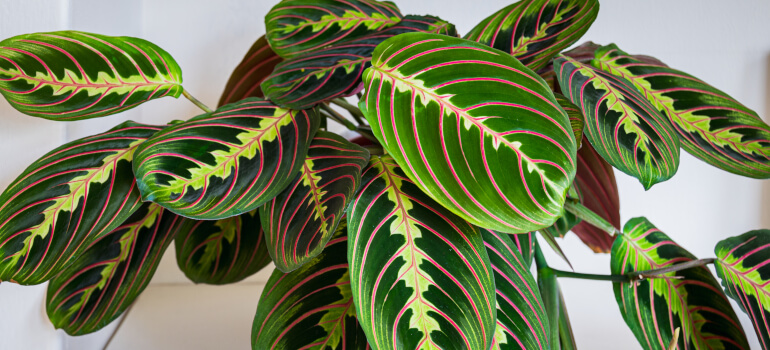
Latin name: Maranta leuconeura
Description: Prayer plant seems easy to grow but it actually some very specific needs. To thrive has to be fed with fertiliser every two weeks all through spring to fall. It loves the sun and humid air. Just like for many other plants, keep the soil moist but not soggy. During winter, when the plant goes into dormancy, leave the soil a bit drier and stop using fertiliser. The plant still needs humid air, so you can use different tactics to achieve that. Here are some ideas.
Children: Safe for children.
Pets: Safe for cats and dogs.
Rubber plant / Rubber fig / Rubber bush / Rubber tree / Indian rubber bush
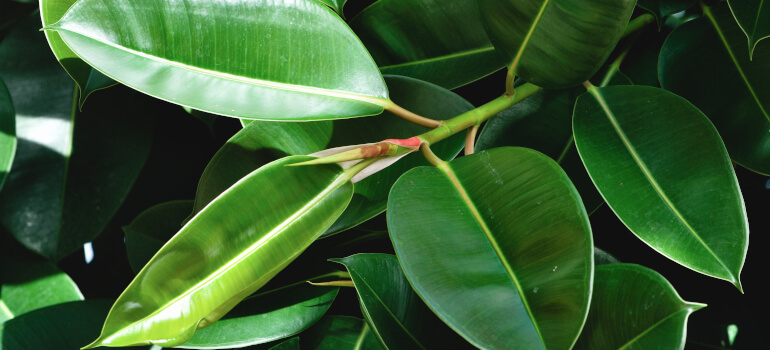
Latin name: Ficus elastica
Description: This beautiful plant with deep green leaves makes a comeback in modern interior design. You can buy it as a very young and small plant and watch how it becomes a big tree over time. You can restrict its growth by leaving it in a smaller pot. When it reaches the desired height cut the top. It will then start to branch out. Pruning dead of dying leaves won’t stop the growth of your Rubber plant so do that when necessary. Place it near a window or leave it outside for the summer and you’ll see it thrive. If you don’t supply it with enough light, it may start losing its lower leaves.
Children: Safe for children.
Pets: Toxic for cats and dogs.
Schefflera / Dwarf umbrella tree

Latin name: Schefflera arboricola
Description: The Schefflera can come in many shapes and forms. In the wilderness it can grow up to 30 ft so you might not expect this big plant to find its way to you living room in a pot. It also is one of the most popular trees for bonsai thanks to its beautiful aerial roots. You can easy propagate Schefflera from cuttings and you can expect them to start growing in a month. It looks best when there are several plants placed in one pot. It can be a great addition to any spacious room and can be used as a natural air refreshener. Unfortunately, it’s not suitable if you have pets because it’s extremely toxic for them.
Children: Safe for children.
Pets: Toxic for cats and dogs.
Sensitive plant / Sleepy plant / Dormilones / Touch-me-not / Shy plant
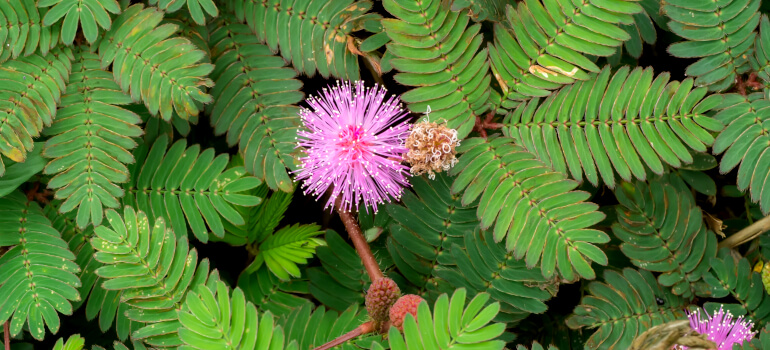
Latin name: Mimosa pudica
Description: The Sensitive plant got it’s name from the way it closes its leaves when something touches them. It’s a tropical creeping annual plant which, in contrast to its reputation, isn’t at all that sensitive. It’s actually considered as an invasive weed in many places and doesn’t need much care. It likes full sun and moist soil. And as you can guess, since it’s a tropical plant, it cannot tolerate cold weather, so keep inside during winter and away from the cold windows. With its responsiveness, the Mimosa can be very attractive to children, so keep that in mind even though it’s not toxic.
Children: Safe for children.
Pets: Safe for cats and dogs.
Snake plant / Mother-in-law’s tongue / Viper’s bowstring hemp
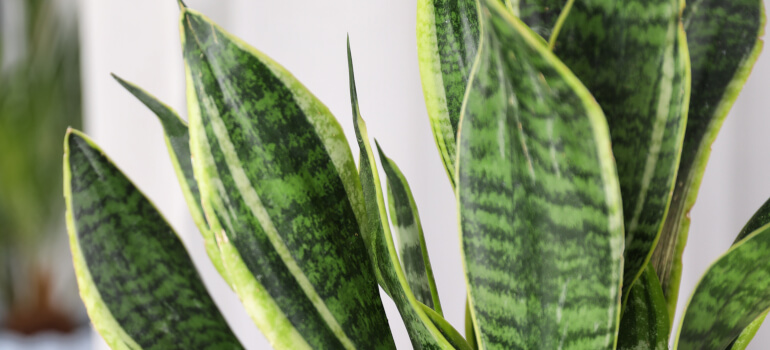
Latin name: Sansevieria trifasciata
Description: A very tolerant plant. You can even forget it exists and it’ll still manage to survive. It can go through periods of drought, low light, insect problems, etc and it’ll still look fresh. If you want it to thrive, just provide it with some sunlight and don’t water it too much. If that isn’t the perfect house plant! It’s also a great air purifier. If you want to propagate a Snake plant the best method is to divide it. Put it in a small pot as it likes cramped spaces (I know, right!). The only downside is that it’s kind of prickly so it might not be the most suitable plant if you have small children.
Children: Safe for children.
Pets: Toxic for cats and dogs.
Spider plant / Airplane plant / St. Bernard’s lily / Spider ivy / Ribbon plant

Latin name: Chlorophytum comosum
Description: Adaptable, one of the easiest to grow, safe for children, safe for pets. Perfect! If you’re a newbie gardener, this can be your first experiment as it’s one tough plant. Water the spider plant generously, but don’t let the soil be soggy and wait for it to dry in between waterings. When you start seeing roots peeking from the soil, you need to re-plant it in a larger pot. A mature plant blossoms in spring and grows small spiderettes which you can plant to have a few more of this easy-going plant.
Children: Safe for children.
Pets: Safe for cats and dogs.
Swedish ivy / Swedish begonia / Whorled plectranthus
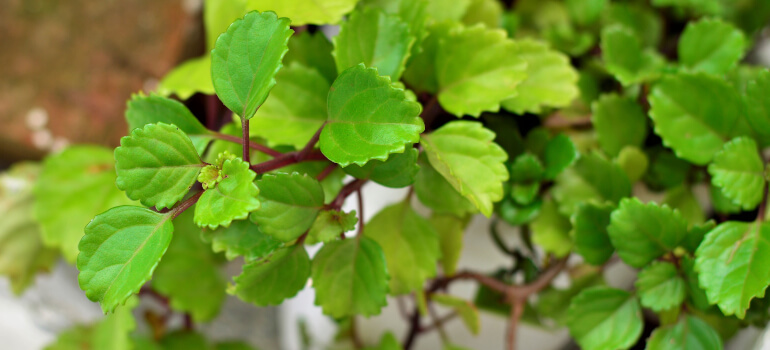
Latin name: Plectranthus verticillatus
Description: This vine-looking beauty can find its way to many homes as even noobie gardeners can take a good care of it. Even though it kind of resembles an ivy with its cascading stems, it isn’t, it’s closely related to the mint. You can refreshen any place by putting the Swedish ivy in baskets and letting it hang from the ceiling. It likes bright direct light and doesn’t tolerate cold, so if you keep it on the balcony, bring it inside at the end of summer. It prefers humid environments, so pulverising it from time to time can help it thrive. Water it sparingly, overwatering may kill your plant. To keep it from becoming too leggy, pinch off the tips after it flowers.
Children: Safe for children.
Pets: Safe for cats and dogs.
Velvet plant / Purple passion
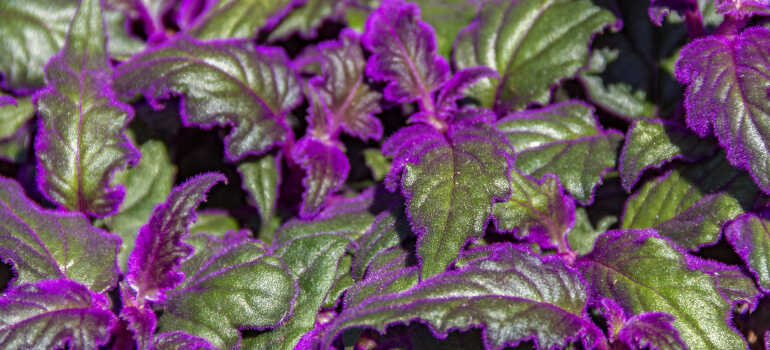
Latin name: Gynura aurantiaca
Description: If you want to have an uncommon addition to your little home garden – the velvet plant is just for you. It has peculiar looks – long soft and fuzzy purple leaves, which can make any place a bit more sophisticated. It grows fast but its lifespan is around 2-3 years, so it’s a good idea to propagate the mature plant while you still can. To do that – give it a trim, place the cuttings in water and after a while they’ll be ready to plant. Remember that you can bring out the purple colour more if you place the plant in a sunny place. The more sun, the more intense the colour gets. If the colour starts to fade now you know what causes it and what to do. The Velvet plant has one small downside – it has foul-smelling flowers. But the solution to that problem is easy – when it blossoms, just snip the flowers off.
Children: Safe for children.
Pets: Safe for cats and dogs.
Wandering jew / Small-leaf spiderwort / River spiderwort / Inch plant / Wandering trad / Wandering willie / Wandering gypsy

Latin name: Tradescantia fluminensis
Description: There are several types of the Wandering jew plant. The Tradescantia fluminensis is a creeping plant with small fleshy leaves. It is tolerant to shade and usually thrives in forests. It can live in wet or moist soil, high and low temperatures, but it’s intolerant to drought and frost. You might wonder why is it named Wandering jew? Because the plant changes the direction it grows at every “joint”. It’s considered an invasive plant – it grows fast (about an inch a week) and can take over other plants which won’t be a problem if you’re growing it in a pot.
Children: Safe for children.
Pets: Toxic for cats and dogs.
Weeping fig / Benjamin fig

Latin name: Ficus benjamina
Description: The Benjamin fig is one of the most popular miniature trees to take care of at home. You can control how much it grows, so it’s one of the suitable trees for bonsai. You can put it on a window sill or on the floor. It has small pointy (but not prickly) leaves which can be either all green of green with white edges and it can often be seen in offices. One thing you should keep in mind about the Weeping fig is that it doesn’t like to be moved in different spots around the house. It most probably will shock the Benjamin fig and it will start shedding its leaves. Just keep the soil wet, not moist and you might enjoy this pretty little tree for years.
Children: Safe for children.
Pets: Toxic for cats and dogs.
Identifying plants
In case you didn’t see your plants on the list we advise you to contact a local expert gardener to identify them. Then you can contact your regional Poison Information Informational Hotline on 13 11 26 with the Latin or the most common name of the plant.
Get a local gardener to grow your plants for you!
Book your service quickly online!




